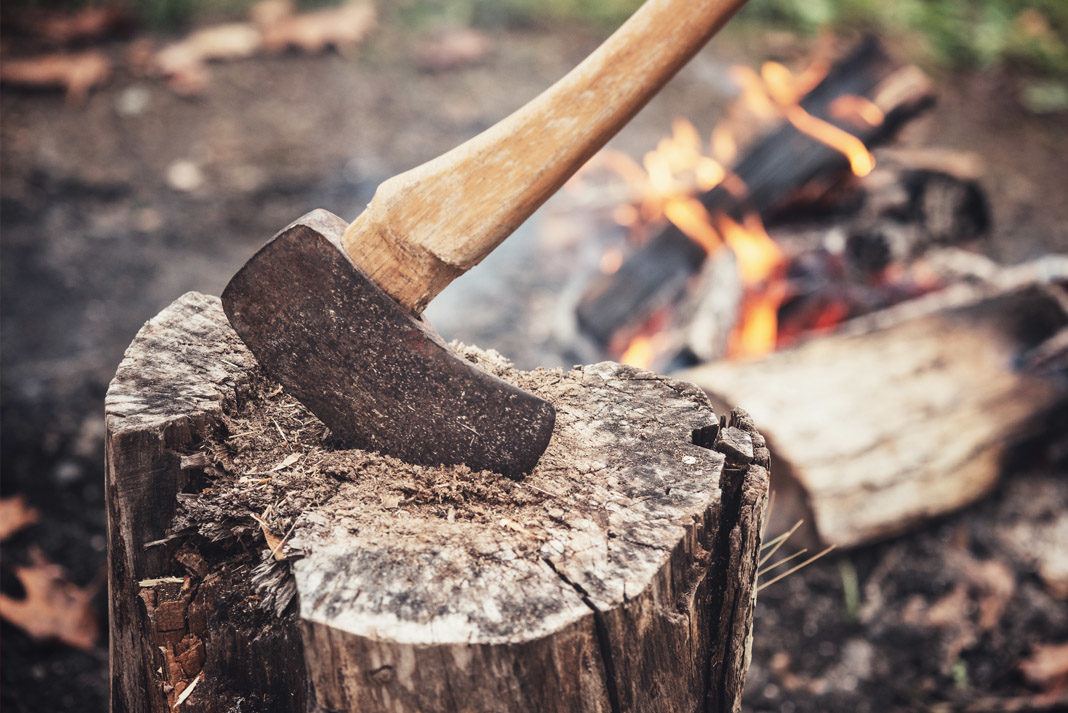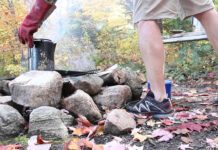The pop culture world of urban bearded men reclaiming their masculinity by dressing like lumberjacks has made the axe cool again
In the backcountry however roars a great fireside debate as to whether the axe is indeed an outdated tool or a valuable asset if proper technique can be taught to the next generation.
At Camp Temagami in Northeastern Ontario, axes have always been seen as an assets. They are an essential tool used for keeping portages open, improving campsites, repairing canoes and for gathering wood to fuel the fires they use to cook camp meals for large groups.
Their axe and saw section of their handbook, written by Neil McDonald, states,
Axes are the most integral part of a traditional approach to tripping. No other tool better illustrates the gap that exists between camping for a few weeks in the summer and acquiring the skills to live outside.
Priorities at Camp Temagami include teaching good axe care, but also good axe chopping, as inevitably, campers want to use the classic backcountry tool.
Much like canoes and paddles, axes have differentiating features, purposes and designs.
Balancing an axe with two fingers below its throat, right behind the axe head on the handle you can tell if your axe is bit heavy, when the axe head pulls down, or poll heavy, when the handle end drops down. Bit heavy axes are most common, however they have a tendency to dive towards your shins if you strike a glancing blow.
Conventional logic states a longer handle is safer to use by giving more space between the target and the subject. However, a lighter head on a small handle will give most campers a better connection with the axe. It will also be easier to use with one hand. The average adult prefers an axe head weighing one-and-a-half to two-and-a-half pounds with a handle 24 to 28 inches long.
“Good axe work is a thing of beauty: the pleasure of using one well compares with the inherent grace of any other elegant physical activity,” writes McDonald.
Beauty is in the eye of the beholder of the axe.
There are different methods for splitting firewood with an axe.
Some sources like Cliff Jacobson in his book, Camping’s Top Secrets, suggest splitting rounds by placing a hatchet or axe blade in the piece of wood and using a log to tap the blade in.
McDonald however, suggests, “Hatchets and axes have handles because they are designed to be swung.” McDonald adds that, “A hatchet’s short handle does make it dangerous to swing hard, and someone could easily cut themselves badly.” He would rather give campers the proper tool and teach them to use it well.
Use a chopping block to ensure your axe head isn’t damaged by being lodged in the dirt or by hitting rock if you strike a glancing blow. Blocks also increase your own safety, making it less likely the head will continue toward your leg or feet.
Since perfect upright chopping blocks are hard to come by in the backcountry, finding a sturdy log or piece of driftwood about six feet long is ideal for resting log rounds against for chopping.
Standing on the opposite side of the log, positioning yourself like a batter to home plate, slowly do a test swing to see if you are the appropriate distance from the round. We could debate the over-the-head-straight-down motion or the side-and-down motion as being more accurate or safe, but we’ll leave that for the lumbersexuals and their cinnamon-flavored cappuccinos.
“Trying to muscle the swing or simply swinging harder, usually decreases accuracy. Staying loose, breathing regularly and focusing on the end point will help you strike where you want,” says McDonald.
If there are noticeable cracks in the log round, place them face down. The force from hitting the other side of the round is more likely to split the wood than your aim being perfect enough to hit and expand the cracks.
As you would imagine, axe angles and sharpness have the greatest effect on their performance.
Splitting axes have wide bevels, while cutting axes have fine bevels to slice into trees with ease. Having one or the other will not be as helpful as having a well-rounded axe in the backcountry. McDonald suggests anywhere between a 15-degree to a 20-degree bevel will get you through your canoe trips with ease.
Using an axe takes you into the forest in the way that traveling without one doesn’t,” writes McDonald. “You begin to pay attention to tree species and distribution and to notice characteristics that add value to the tripping experience.









